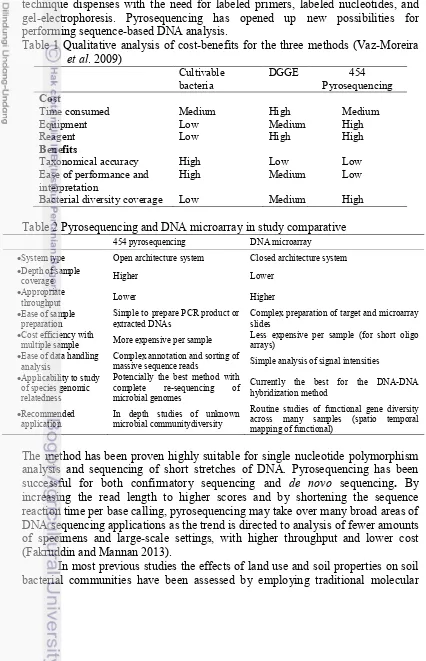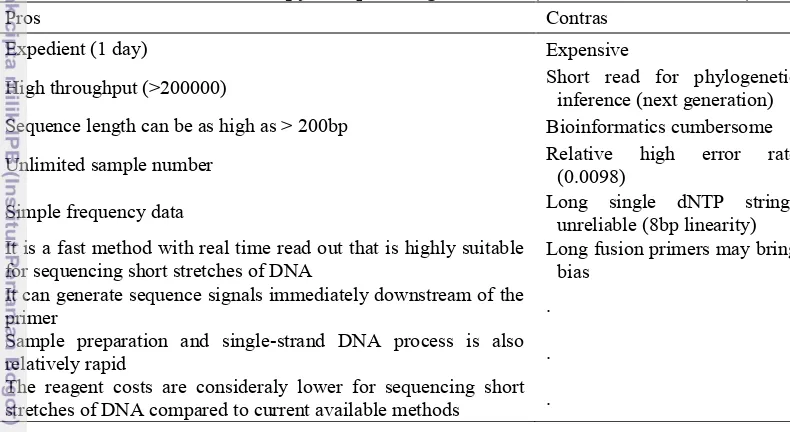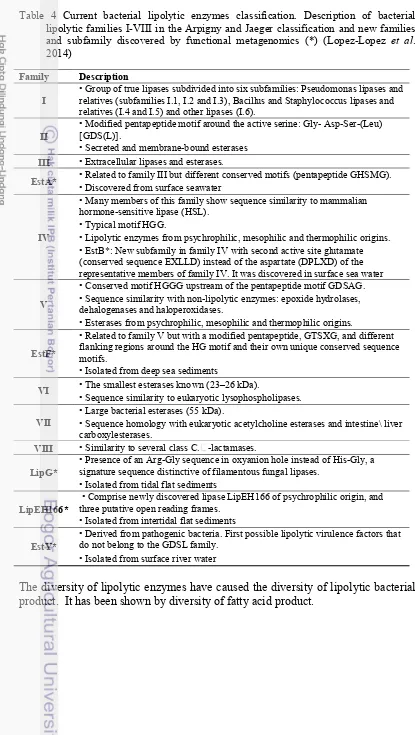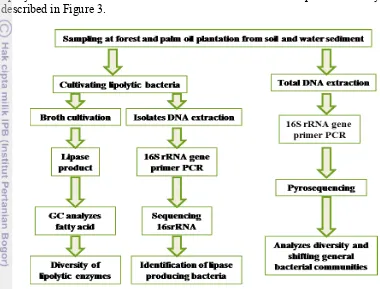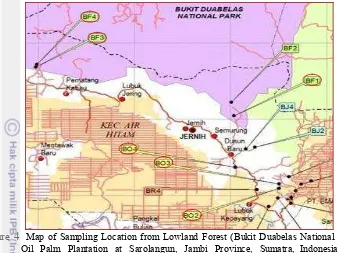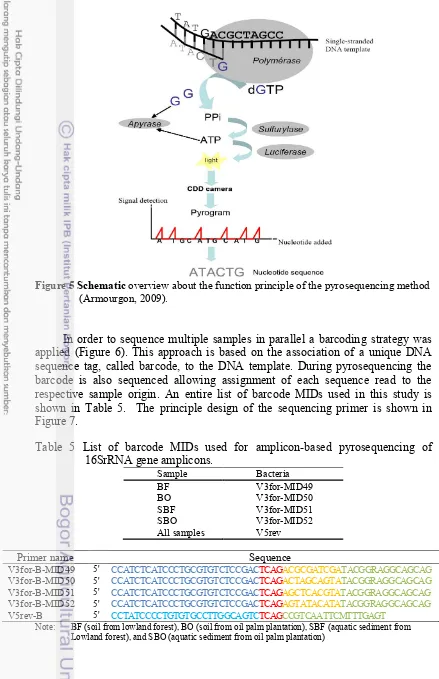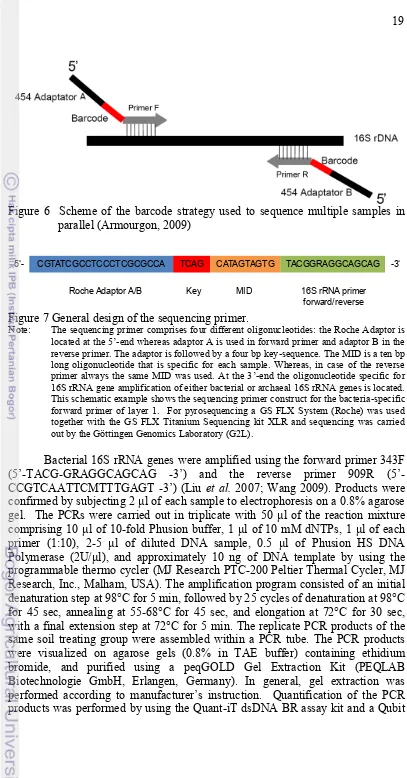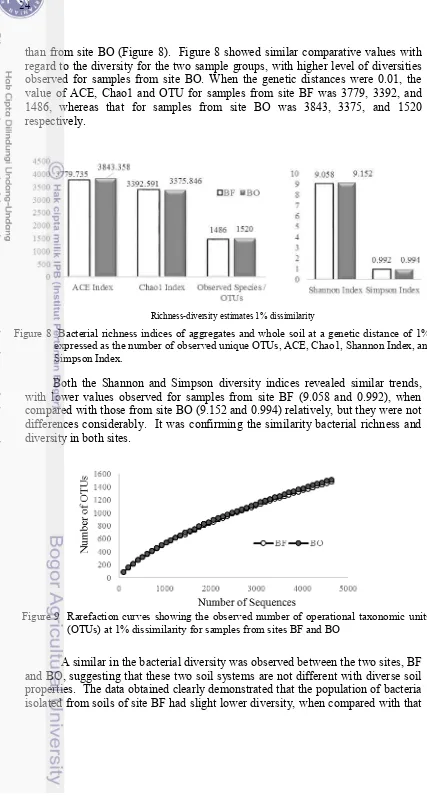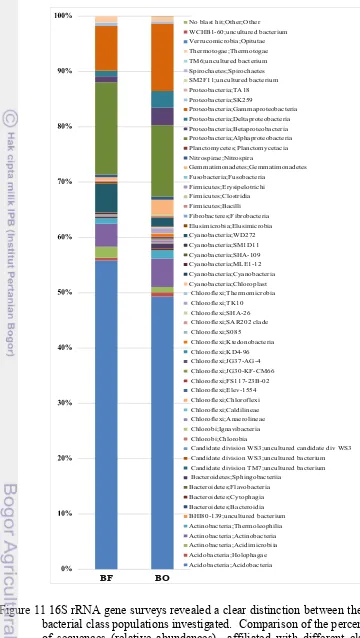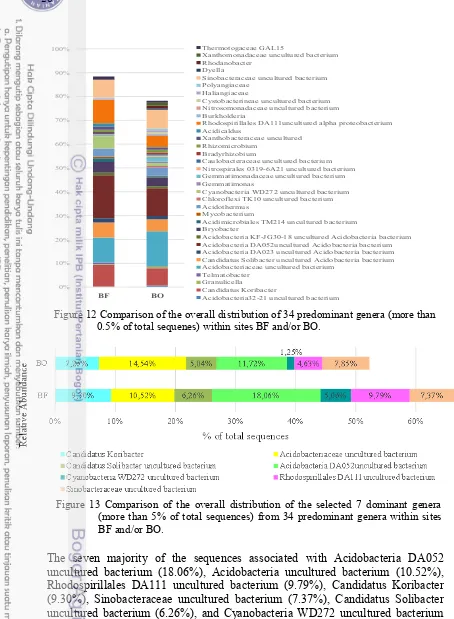BACTERIAL DIVERSITY AND LIPASE PRODUCING
BACTERIA IN FOREST AND OIL PALM PLANTATION AT
SAROLANGUN JAMBI INDONESIA
MARINI WIJAYANTI
GRADUATE SCHOOL
BOGOR AGRICULTURAL UNIVERSITY BOGOR
DECLARATION OF THE SOURCE OF THIS DISSERTATION
I declare that this dissertation, entitled Bacterial Diversity and Lipase Producing Bacteria in Forest and Oil Palm Plantation at Sarolangun Jambi Indonesia is entirely my own work, assisted by a supervisory committee and has not been submitted in any form for another degree or diploma to any university or other tertiary institution of education. Where this dissertation draws on existing publications, those sources are cited in the text and listed in the references section.
Bogor, August 2015 Marini Wijayanti
RINGKASAN
MARINI WIJAYANTI. Keragaman Bakteri dan Bakteri Penghasil Lipase dalam Hutan dan Perkebunan Sawit di Sarolangun Jambi Indonesia. Dibimbing oleh ANJA MERYANDINI, ARIS TRI WAHYUDI, and MUNTI YUHANA.
Deforestasi untuk pembukaan lahan perkebunan sawit paling masif terjadi di Asia Tenggara. Hal ini berdampak negatif pada keragaman hayati dan lingkungan. Tanah dan sedimen pada penelitian ini diperoleh dari lapisan atas tanah hutan dataran rendah dan perkebunan sawit, serta perairan yang disekitar situs tersebut. Hutan tersebut berlokasi di Taman Nasional Bukit Duabelas, dan perkebunan sawit sekitar hutan di Sarolangun Jambi Indonesia. Keragaman komunitas bakteri dari tanah dan sedimen perairan area hutan dan kebun sawit Sumatra dipelajari menggunakan pyrosequencing gen 16S rRNA dan indeks keragaman umumnya. Pendekatan filogenetik digunakan untuk mengungkap perubahan komunitas filotipe bakteri dan genusnya di kedua area. Pendekatan ekologis menggunakan nilai pH, kandungan Karbon (C) total, Nitrogen (N) total, Fosfor (P) tersedia dan keragaman bakteri menggunakan indeks Shannon dan Simpson, dan kelimpahan bakteri dengan indeks Chao1-ACE dan OTUs. Keragaman dan kelimpahan bakteri tanah di hutan dan kebun sawit tidak berbeda sebagaimana pH, C total, dan N total, sebagai faktor substrat yang tidak berbeda nyata. Tetapi, indeks kelimpahan bakteri di sedimen perairan area hutan justru lebih tinggi dari area kebun sawit.
Bakteri spesial di hutan dan lahan sawit adalah bakteri lipolitik. Enzim bakteri tersebut telah diaplikasikan di industri agroakuakultur, pangan, deterjen, farmasi, susu, maupun biodiesel-biokerosin. Informasi keragaman bakteri lipolitik asal tanah dan sedimen perairan di areal hutan dan perkebunan kelapa sawit, dan komposisi asam lemaknya diperlukan. Sebanyak 22 isolat terpilih dari tiga puluh dua isolat bakteri lipolitik yang tumbuh pada media selektif lipolitik, terdiri atas 11 isolat dari tanah lapisan atas dan 11 isolat dari sedimen air di hutan dan daerah perkebunan. Isolat-isolat bakteri diidentifikasi berdasarkan analisis gen 16S rRNA. Hasil identifikasi menunjukkan isolat-isolat tersebut terdiri atas lima genera yaitu Burkholderia, Cupriavidus, Serratia, Acinetobacter, dan Kurthia. Pada pohon filogenetik yang dibangun menggunakan metode maximum likelihood, isolat-isolat tersebut terdistribusi ke dalam tiga grup, yaitu grup Burkholderia-Cupriavidus, grup Serratia-Acinetobacter, dan grup Kurthia. Hasil analisis kromatografi gas (GC-FID) menunjukkan bahwa enzim lipolitik yang dihasilkan bakteri-bakteri tersebut memproduksi berbagai asam lemak. Beberapa isolat bakteri menghasilkan asam lemak esensial, seperti asam lemak: linoleat, linolenat, arakidonat, eikosapentanoat (EPA), dan dokosaheksanoat (DHA). Untuk masa depan, bakteri lipolitik dari hutan dan perkebunan sawit dapat dilanjutkan penelitian untuk kesejahteraan lingkungan dan manusia.
SUMMARY
MARINI WIJAYANTI. Bacterial Diversity and Lipase Producing Bacteria in Forest and Oil Palm Plantation at Sarolangun Jambi Indonesia. Supervised by ANJA MERYANDINI, ARIS TRI WAHYUDI, and MUNTI YUHANA.
Deforestation for oil palm plantation are the most invasive land use changes in Southeast Asia. It has impacted its rich and unique biodiversity. On the other hand, conversion of land to agricultural use such as oil palm plantations has even more negative impacts for environment. Soil dan sediment samples used in this study were obtained from topsoil in a lowland forest and on an oil palm plantation and from sediments in fresh water near these sites. The forest is located in Bukit Duabelas National Park, and the oil palm plantation is near the forest in Sarolangun District, Jambi Province, Indonesia. The diversity of bacterial communities from top soil and aquatic sediment lowland rainforest and oil palm plantation in Sumatra was studied using pyrosequencing of 16S rRNA gene and common biodiversity indices. Phylogenetic approach was used for revealing the community shift of bacterial phyla and genera in both areas. Ecological approach used soil pH, TC (Total Carbon), TN (Total Nitrogen), AP (Available Phosphorous) values measurement and bacterial diversity with Shanon and Simpson indices, and bacterial richness with Chao1-ACE index and OTUs. Bacterial diversity and richness in top soil lowland forest and oil palm plantation soil were not different, as soil pH, TC, and N as substrate factors were not different significantly. But, bacterial richness indices in aquatic sediment of forest area were higher than in plantation area.
The majority of sequences related to Acidobacteria (56.33%), Proteobacteria (27.43%), Actinobacteria (7.11%), and Cyanobacteria (5.55%) were from soil forest; whereas those related to Acidobacteria (50.11%), Proteobacteria (31.63%), Actinobacteria (7.58%), Chloroflexi (2.60%), and Gemmatimonadetes (2.71%) invented from soil of oil palm plantation. Acidobacteria was the most dominant phyla in both habitats, because soil pH in both areas was acidic (3.77 – 4.80 pHH2O). The genera of Alphaproteobacteria dominated in genera phylotype of
bacterial 16S rRNA gene phylogenetic revealed both topsoil forest and oil palm plantation. The most genera in phylogenetic tree was Burkholderia from Betaproteobacteria. Differently from soil, in aquatic sediment, the majority of sequences related to Proteobacteria (34.85%), Acidobacteria (32.67%), Nitrospirae (6.86%), Chloroflexi (4.31%), and Actinobacteria (4.02%) were from forest; whereas those related to Acidobacteria (46.10%), Proteobacteria (25.86%), Nitrospirae (9.20%), Chloroflexi (4.99%), and Actinobacteria (2.34%) invented from oil palm plantation. Acidobacteria still was the most dominant phyla in oil palm sediment habitats. The genera of Alphaproteobacteria and Betaproteobacteria dominated in genera phylotype of bacterial 16S rRNA gene phylogenetic revealed both aquatic sediment of forest and oil palm plantation.
occured in forest transformation, eventough the oil palm plantation showed more bacterial phyla and genera than the lowland forest. Contrary, the bacterial community shift occured in aquatic sediment of forest transformation, as like as the aquatic sediment from forest area showed more bacterial diversity index, richness index, phyla, and genera than these ones from oil palm plantation.
The special bacteria in forests and on oil palm plantations are lipolytic bacteria. Their enzymes have been applied in the agro-aquaculture, food, detergent, pharmaceutical, dairy, and biodiesel-biokerosene industries. The diversity of cultivable lipolytic bacteria from soil and aquatic sediment in a forest and on an oil palm plantation and their fatty acid products. Twenty-two isolates of lypolitic bacteria were selected from 32 isolates grown in lipolytic selective medium. The 22 consisted of 11 isolates from topsoil and 11 from aquatic sediment from the forest and plantation area. These isolates were identified by 16S rRNA gene-sequence data analysis. Taxonomically, they belonged to five genera: Burkholderia, Cupriavidus, Serratia, Acinetobacter, and Kurthia. The maximum likelihood tree showed that they are phylogenetically distributed in three clusters. They were clustered into three groups: the Burkholderia -Cupriavidus group, the Serratia-Acinetobacter group, and the Kurthia group. Their lipolytic enzymes formed various fatty acids after analysis by gas chromatography-flame ionization detector (GC-FID). Some isolates formed essential fatty acids, such as linoleic, linolenic, arachidonic, eicosapentanoic acid (EPA), and docosahexanoic acid (DHA). In future, lipolytic bacteria from forest and oil palm plantation can be continued research for human and environment welfare.
©Copyright Bogor Agricultural University, 2015
This copyright is protected by law
Any unauthorized quotation of part or this entire dissertation without referencing the author and institution is prohibited. Reproduction of this material is only permitted for research and education purposes and must not undermine the rights of Bogor Agricultural University
Marini Wijayanti
Dissertation
as one of the requirements of the PhD program in the Major Microbiology
GRADUATE SCHOOL
BOGOR AGRICULTURAL UNIVERSITY
BOGOR
2015
BACTERIAL DIVERSITY AND LIPASE PRODUCING
BACTERIA IN FOREST AND OIL PALM PLANTATION AT
Examiners in the Closed Examination: 1. Dr I Made Artika, MAppSc 2. Dr Iman Rusmana, MSi Examiners in the Doctoral Promotion:
Title of Dissertation : Bacterial Diversity and Lipase Producing Bacteria in Forest and Oil Palm Plantation at Sarolangun Jambi Indonesia
Name : Marini Wijayanti Student ID : G 361110011
Major : Microbiology
Approved by the Supervisor Committee
Prof Dr rer nat Anja Meryandini, MS Head of Committee
Prof Dr Aris Tri Wahyudi, MSi Dr Munti Yuhana, MSi Member of Committee Member of Committee
Authorized by,
Head of Major Microbiology Dean of Graduate School
Prof Dr rer nat Anja Meryandini, MS Dr Ir Dahrul Syah, MSc Agr Date of Closed Examination :
11 August 2015
Date of Doctoral Promotion : Date of Graduation : 28 August 2015
ACKNOWLEDGEMENTS
Alhamdulillahirabbil’alamin. It would not have been possible to complete this dissertation without the support, patience and guidance of the following people. It is to them that I owe my deepest gratitude.
My promotor, Prof Dr rer nat Anja Meryandini, MS for her endless support, enthusiasm, knowledge and patience
My co-promotor, Prof Dr Aris Tri Wahyudi, MSi for his support, guidance and knowledge during my graduate study at Bogor Agricultural University
My co-promotor, Dr Munti Yuhana for his support, guidance, and input throughout finalizing my dissertation.
Aquaculture Program, Faculty of Agriculture, Sriwijaya University and Indonesian Minister of Education for the doctorate scholarship and research funding (BPPS-DIKTI 2011 and Hibah Disertasi Doktor 2014)
Dr Ir Gayuh Rahayu,MS and Prof Dr rer nat Anja Meryandini, MS as former Head and Head of Graduate Programe Microbiology in Bogor Agricultural University for their support during my study, respectively.
Dr Iman Rusmana, MSi for his support and guidance to think as microbiologist
Prof. Rolf Daniel and Martin Engelhaupt (R.I.P) for facilitating the molecular work at the Genomic Laboratory, the Institute of Microbiology and Genetics at George-August University, Göttingen, Germany, via CRC990 EFForTS project B02.
Dr I Made Artika, MappSc and Dr Achmad Dinoto as examiners at the closed examination and the doctoral promotion.
My fellow postgraduate students and friends both at Bogor Agricultural University Susan Soka, Tri Handayani Kurniati, Ifah Munifah, Roni Ridwan, Sipriyadi, Wahyu Ekasari, Violita, Ernin Hidayati, Dade Jubaedah and her husband Julisman, Ani Suryanti, Andi Dharmawan, Zamroni, Bu Catur, Bu Yayin, Bu Nina, and graduate students of BOT, AKU, and SDP, Nur Rohmah Kumalasari, Desniar, Siti Nuryati, Pak Jaka, Bu Dewi, Bu Heni, Bu Hely and the others for their support and friendship.
Finally, and most importantly, I take this opportunity to express my gratitude to my family for their love, unfailing encouragement and support. I would like to thank my husband, Mohamad Amin, for his patience during the ups and downs of my study. I would like to thank my daughter and son, Nurfahmia Marisa Amin and Muslih Munadi Amin, for their loves and supports. I thank my parents and sister, Budi Wijaya Adi, Sumarsi, and Marheni Wijayanti, for their love and faith in me. And also, I thank Amin’s parents, for providing me with unending encouragement and support.
Bogor, August 2015
CONTENTS
LIST OF TABLE xiii
LIST OF FIGURE xiii
LIST OF APPENDIX xiv
1 INTRODUCTION 1
Background 1
Hypothesis 3
Objectives 3
Novelty 3
Outcomes 3
2 LITERATURE REVIEW 4
Bacterial Diversity in Shifting Environment 4
Pyrosequencing for Reveal Bacterial Community Shift 7
Lipase Producing Bacteria 9
Lipase Diversity 11
3 MATERIALS AND METHODS 15
Soil and sediment sampling 15
DNA Extraction from soil/sediment 16
454-Pyrosequencing 17
Isolation of cultivable lipase-producing bacteria 20
Profile of Fatty Acid Product using GC-FID 21
DNA sequencing of 16S rRNA gene 21
Phylogenetic analysis 21
4 RESULTS AND DISCUSSIONS 22
Soil Bacteria in Forest and Oil Palm Plantation 22 Environmental variable and bacterial diversity indices 22 Effect of soil properties on bacterial diversity 23 Bacterial communities composition in forest and oil palm plant. 25 Phylogenetic of bacterial communities for BF and BO sites 31 Sediment Bacteria in Forest and Oil Palm Plantation 36 Environmental variable and bacterial diversity indices 37 Effect of sediment properties on bacterial diversity 38 Bacterial communities composition in forest and oil palm plant. 40 Phylogenetic of bacterial communities for SBF and SBO sites 45 Soil and Aquatic Sediment Bacteria Reveal Shifting Bacterial
Comunities in Forest and Oil Palm Plantation 51 Lipolytic bacterial isolates obtained from forest and oil palm plantation 54
Diversity of fatty acid production 58
5 CONCLUSIONS 60
REFERENCES 60
APPENDIX 71
LIST OF TABLES
1. Qualitative analysis of cost-benefits for the three method 8 2. Pyrosequencing and DNA microarray in study comparative 8
3. Pro and contras of pyrosequencing methods 9
4. Current bacterial lipolytic enzymes classification 14 5. List of barcode MIDs used for amplicon-based pyrosequencing of
16S rRNA gene amplicons 18
6. Mean values (±standard deviation) of soil parameters for soil samples from the forest site (BF) and the oil palm plantation site
(BO). 22
7. Mean values (±standard deviation) of parameters for sediment samples from the forest site (SBF) and the oil palm plantation site
(SBO). 38
8. Isolates of lipolytic bacteria from forest and oil palm plantation soil
and aquatic sediment and their lytic zones 55
9. Yield of unwanted and essential fatty acid produced by isolates of lipolytic bacteria from soil and aquatic sediment bacteria per
substrate (olive oil) 55
LIST OF FIGURES
1 Pathways used by bacteria to secrete lipolytic enzymes 11
2 Reaction catalyzed by lipase 13
3 Diagram of general methods of this study 15
4 Map of sampling location from lowland forest (Bukit Duabelas
National Park) and oil palm plantation 16
5 Schematic overview about the function principle of the pyrosequencing
method 18
6 Scheme of the barcode strategy used to sequence multiple samples in
parallel 19
7 General design of the sequencing primer 19
8 Bacterial richness indices of aggregates and whole soil at a genetic
distance of 1% 24
9 Rarefaction curves showing the observed number of operational
taxonomic units 24
10 Average relative abundances of dominant bacterial taxa in samples collected at forest (BF) and oil palm plantation (BO) area 26 11 16S rRNA gene surveys revealed a clear distinction between the two
bacterial class populations investigated 27
12 Comparison of the overall distribution of 34 predominant genera (more than 0.5% of total sequenes) within sites BF and/or BO 28 13 Comparison of the overall distribution of the selected 7 dominant
genera (more than 5% of total sequences) from 34 predominant genera
Cont.
14 16S rRNA gene -based phylogeny showing representatives of all bacterial phyla from tropical low land secondary forest soil derived
sequences have been obtained 32
15 16S rRNA gene-based phylogeny showing representatives of all bacterial phyla from oil palm plantation soil derived sequences have been
obtained 33
16 16S rRNA gene-based phylogeny showing representatives of
Burkholderia and other Burkholderiales 36
17 Bacterial richness indices of aggregates and whole sediment at a
genetic distance of 1% 39
18 Rarefaction curves showing the observed number of OTUs at 1% dissimilarity for samples from sites SBF and SBO 39 19 Average relative abundances of dominant bacterial taxa in sediment
samples collected at forest (SBF) and oil palm plantation (SBO) area 42 20 16S rRNA gene surveys revealed a clear distinction between the two
bacterial class populations investigated SBF SBO 43 21 Comparison of the overall distribution of 50 predominant genera (more
than 0.5% of total sequenes) within sites SBF and/or SBO 44 22 Comparison of the overall distribution of the selected 12 dominant
genera (more than 5% of total sequences) from 50 predominant genera
within sites SBF and/or SBO 44
23 16S rRNA gene-based phylogeny showing representatives of all bacterial phyla in aquatic sediment of forest area 46 24 16S rRNA gene-based phylogeny showing representatives of all
bacterial phyla in aquatic sediment of oil palm plantation area 47 25 16S rRNA gene-based phylogeny showing representatives of
Burkholderia and other Burkholderiales 49
26 Rarefaction curves showing the observed number of operational taxonomic units (OTUs) at 1% dissimilarity for samples from sites forest (BF, SBF) and oil palm (BO, SBO) plantation, with means of pH value and available
phosphorus (AP) 52
27 Phylogenetic Tree Constructed by Maximum Likelihood Method Based on 16s rRNA Gene Sequences Data of 22 Lipolytic Bacterial Isolates 56
LIST OF APPENDIXES
1 Overview Quality Filtering of 454 Pyrosequencing Data 71 2 Composition of fatty acids (microgram methylester/mg supernatant
1
I
NTRODUCTION
Background
Southeast Asia is one of the most important hot spots of biodiversity. It has been reported that in this region the above-ground diversity has been strictly affected by land use changes. Deforestation and agricultural intensification are the most invasive land use changes in Southeast Asia. In contrast to other tropical regions, Southeast Asia has the highest deforestation rate. It has impacted its rich and unique biodiversity. On the other hand, conversion of forest to agricultural use such as oil palm plantations has even more negative impacts for environment (Tripathi et al. 2012). Between 1999‒2006, 3.5 million hectares of Indonesian forest were damaged per year. Between 2006‒2010, 2 million hectares per year were damaged, and between 2010‒2012, 300,000 hectares per year. In Jambi Province, Sumatra, Indonesia, land has been transformed from forest to temporary cropland and agro-forest (Partohardjono et al. 2003). Loss of environmental services provided by forests is a non-linear process in this province. A gradual simplification of complex agro-ecosystems to agro-forests with increased profitability might be threatened by the oil palm plantation industry (Mudiyarso et al. 2002).
The tropical low land forests are ecosystems that are rich in endemic species of flora, fauna and microbes like Bacteria. Lee-Cruz et al. (2013) reported that bacteria were grouped into operational taxonomic units (OTUs) at the 97% similarity level, and OTU richness and local-scale diversity (alpha-diversity) showed no difference between the various forest types and oil palm plantations. But, focusing on the turnover of bacteria across space, true diversity (beta-diversity) was higher in oil palm than in forest, whereas community dissimilarity-based metrics of -diversity were only marginally different between habitats, suggesting that at large scales oil palm could have higher overalldiversity (gamma-diversity) than forest, driven by a slightly more heterogeneous community across space. Clearance of primary and logged forest for oil palm did, however, significantly impact the composition of soil bacterial communities, reflecting in part the loss of some forest bacteria, whereas primary and logged forests did not differ in composition. The soil bacteria of tropical forest are to some extent flexible or resistant to logging, but that impacts of forest conversion to oil palm are more severe (Lee-Cruz et al. 2013). Fluctuations of diversity of bacterial community in lowland forest and oil palm plantation in Jambi, Indonesia, have not been scrutinized yet. The impact of lowland rainforest transformation to oil palm plantation on phylogenetic of soil and freshwater sediment bacterial communities in Sumatra, Indonesia has not been studied.
addition, variation in phylogenetic structure of dominant lineages
(Alphaproteobacteria, Betaproteobacteria, Gammaproteobacteria, Acidobacteria,
and Actinobacteria) is also significantly correlated with soil pH. Together, these results confirm the importance of soil pH in structuring soil bacterial communities in Southeast Asia. Soil bacteria in oil palm plantation is actually richer than primary forest (Tripathi et al., 2012). Among the most abundant operational taxonomic units (OTUs), there was clear evidence of niche partitioning by pH. It showed that pH plays a major role in structuring tropical soil bacterial communities. Soil pH was the best predictor of diversity and community composition of bacteria, being a stronger predictor than land use (Tripathi et al., 2013). The distribution of some bacterial groups and subgroups in different sites correlated with soil properties and vegetation. Soil organic matter (SOM), total nitrogen (TN), and specific plant group were important factors shaping the composition of bacterial communities (Li et al. 2014). Tsiknia et al. predicted that 31–79% of the spatial variation in microbial taxa abundance could be explained by the parameters measured, with total organic carbon and pH being identified as the most important (Tsiknia et al. 2014).
High fertilizer input is necessary to sustain high yields in oil palm agroecosystems, but it may endanger neighboring aquatic ecosystems when excess nutrients are transported to waterways. The low nutrient concentrations recorded in streams throughout the landscape indicated that the mature oil palm plantations in this study did not contribute to eutrophication of aquatic ecosystems. Soil type controlled dissolved inorganic N and total P fluxes, with greater losses of N and P from loamy-sand uplands than loamy lowlands (Comte
et al. 2015). One reason was the conversion of the huge forest zone to oil palm
plantations over the Johor River Basin which caused modifications in the surface soil layer and vegetation canopy. Land-use variation plays a vital role in local water cycle changes, especially for the water movement within the soil layer (Tan et al. 2014). The change of water nutrient cause change of microbial community in the water which is dominated in water sediment habitat. There are increasing oily substrates in soil and water as impact of forest transformation to oil palm plantation area which receive fallen palm oil fruit and oily water from Palm Oil Mill Effluent (POME).
Bacteria are important for most nutrient transformations in soil and are major drivers of bio-geochemical cycles in oil palms plantation. One of special bacteria in oil palm plantation is lipolytic bacteria. Fallen palm oil fruit and debris from the cell membranes of dead animals have provided lipolytic bacteria substrates for degrading and synthesizing many kinds of fatty acids in the soil of oil palm plantations and forests. Lipolytic bacteria have been found in forest grass and soil (Nacke et al. 2011), marine sediment (Hu et al. 2010; Peng et al. 2011), river surfaces (Wu et al. 2009), hot spring water (Tirawongsaroj et al. 2008), agricultural industry waste (Salihu et al. 2012), soil contaminated by wastewater treatment (Glogauer et al. 2012), and endophytic lipolytic bacteria of palm oil fruit (Djafar et al. 2010). Lipolytic bacteria secrete lipase, which is used by many industries. The majority of lipase currently used industrially has been isolated from cultivated bacteria.
extracellular lipases in their environments. These enzymes are capable of hydrolyzing and synthesizing carboxyl esters of long-chain acylglycerol (>10 carbon atoms). They have applications in various industries, such as food, detergent, pharmaceutical, dairy, biodiesel-bio-kerosene, and bioremediation (Jaeger et al. 1999; Casas-Godoy et al. 2012). They can be developed in sustainable agro-aquaculture if the applications are cheaper than those used in industry. Lipases are produced by various organisms, including animals, plants, fungi, and bacteria. Bacterial enzymes are easier to manipulate in culture. Commercially, lipases from bacteria have been produced by Burkholderia cepacia, Pseudomonas mendocina, Pseudomonas alcaligenes, and Chromobacterium viscosum (Jaeger et al. 1999). The various lipase producing bacteria could be found in the forest and oil palm plantation areas. They will be an added value of the bacterial diversity in forest transformation to oil palm plantation.
Hypothesis
Transformation of low land forest (become oil palm plantation) make change of biota diversity. It makes shifting of their bacterial community in top soil and freshwater sediment around them. Bacterial community shift in both habitats might play a role as balancing nutrient in soil and water for natural environment sustainability. Utility of shifting bacterial community is founding unique bacteria for the community welfare.
The dominant bacteria in forest and oil palm plantation soil and sediment are lipase producing bacteria. Diversity of lipolytic bacteria in forest and oil palm plantation should be important to search superior candidate of lipase producing bacteria.
Objectives
The objectives of this study was to describe the diversity of bacteria from low land forest and oil palm plantation (transformation area) in soil and sediment habitats. In this study, phylogenetic approach for analyses the community shift of bacteria between both areas was used. Special bacteria in both areas is lipolytic bacteria. This study also described the diversity of cultivable lipolytic bacteria from soil and aquatic sediment in a forest and in the area of an oil palm plantation, their capability for producing lipases, and their fatty acid composition of product.
Novelty
Outcomes
This bacterial diversity study gave several basic information for shifting bacterial communities in the transformation forest to oil palm plantation. The information could be used by the stake holder for recomendation of land use management, so they will give several policy for preserving the forest area and developing sustainable oil palm plantation for environment welfare.
This lipase producing bacteria study have given several information of lipase diversity invented from forest and oil palm plantation area for developing agro-aqua-industries that use or produce the bacterial lipase.
2 LITERATURE REVIEW
Bacterial Diversity in Shifting Environment, Transformation Forest to Oil Palm Plantation
The bacterial diversity is one of microbial diversity which play important role in the world. The microbial diversity is described as the number of different species and their relative abundance in a given community in a given habitat. The soil is considered as one of the major reservoirs of microbial diversity on our planet (Swift et al. 1998) with an estimated bacterial diversity of 104 to 106 taxa per 1 g of soil (Torsvik et al. 1990, Gans et al. 2005). Torsvik and Overeas (2002) found that 1 g of soil has 4000 different species of microbes and the bacterial population in top layers of soil can be more than 109 individual cells per gram soil. Microorganisms in soil are critical to the maintenance of soil function because of their involvement in key processes like soil formation, decomposition of organic matter, toxin removal and the cycling of carbon, nitrogen, phosphorus, and sulphur (van Elsas and Trevors 1997). Besides soil functions, microbes especially bacteria, are involved in every sphere of human life ranging from industry, medical, food, bioremediation, production of energy, and mining (Sharma et al. 2014). The bacterial diversity was affected by soil ecological processes which resulted by modifications of the soil physicochemical properties and vegetation cover (Rampeloto et al. 2013).
The bacterial diversity of the forest soil was phylum rich compared to the agricultural soils, which are species rich but phylum poor. It is the most comprehensive examination to date of bacterial diversity in soil and suggests that agricultural management of soil may significantly influence the diversity of bacteria and archaea (Roesch et al. 2007). Bacteria not only make up a large proportion of the biological diversity of the rainforest environment but also are a fundamental component of nutrient cycling and productivity. Logging and forest conversion for agriculture drive changes to the soil chemistry; for instance, they can alter the pH, lead to the loss of soil carbon, and modify the C/N ratio and the content of phosphorus and calcium. Bacterial soil communities are in many ways a product of their chemical and physical environment and therefore can be affected by such physicochemical changes to the soil (Lee-Cruz et al. 2013)
The Shannon entropies of multiple communities can be averaged to give what is known in information theory as the ‘‘conditional entropy’’, H, of the set of communities. Because Shannon entropy is a concave function, H is always less than or equal to the gamma entropy H, the entropy of the pooled communities. Though His often called the ‘‘alphadiversity’’ in biology, it is of course really an entropy. It can be converted to the true alpha diversity by Equation:
Likewise the amount of information provided by knowledge of the sample location is often called the beta diversity in biology but is actually an entropy. Like the alpha entropy, it can be converted to the true beta diversity by the Equation. The same tranformation also converts gamma entropy to true gamma diversity.
The relation between the Shannon alpha, beta, and gamma entropy follows directly from information theory:
By converting both sides of this equation to true diversities via the Equation, the relation between alpha, beta, and gamma diversity is obtained:
So, Or
(Alpha diversity)(Beta diversity) = (Gamma diversity)
Forest logging cycles had no effect on alpha-diversity and a small positive effect on true beta-diversity. True beta-diversity, which compares the total OTU richness (alpha-diversity) in relation to the average OTU richness (beta-diversity) for each land use, was higher for twice-logged forests a singletons were removed. Combined, these results suggest that oil palm plantation soil has a higher turnover of bacterial diversity at large spatial scales and is more heterogeneous, whereas bacterial composition in forest soils tends to be more homogeneous. However, the results also suggest that the marginal increase in community dissimilarity beta-diversity in oil palm plantation soil is due to the presence of rare OTUs, because differences disappeared when singleton OTUs were removed (Lee-Cruz et al. 2013).
Soils from oil palm plantations had significantly lower abundances of Acidobacteria than primary forest, whereas Actinobacteria was more abundant in oil palm plantations than in all forests. Similar results have been found for these phyla in studies of soils in the Amazon and forested land in the United States (Bossio et al. 2005, Shange et al. 2012). Acidobacteria are oligotrophic organisms abundant in carbon-poor soils (Nemergut et al. 2010). Carbon and nitrogen content often decreases in cultivated soils, such as lower concentrations of total carbon and total nitrogen and a lower C/N ratio in soil from oil palm plantations than from forests. However, Acidobacteria are also strongly influenced by pH, favoring soils with pH values lower than 4. Primary forest soils had lower pH than oil palm plantation soils, probably promoting Acidobacterial abundance (Lee-Cruz et al. 2013). Oligotrophs exhibit slower growth rates and are likely to outcompete copiotrophs in conditions of low nutrient availability due to their higher substrate affinities. Copiotrophs preferentially consume labile soil organic C pools, have high nutritional requirements, and can exhibit high growth rates when resource conditions are abundant. It follows then that soils with large amounts of available organic C should favor copiotrophs while oligotrophs should predominate in soils where organic C quality and/or quantity is low. Bacteria belonging to the Acidobacteria phylum were most abundant in soils with very low resource availability (low C mineralization rates) and their relative abundances were lowered in an individual soil amended with high concentrations of organic C. In contrast to the oligotrophic Acidobacteria, the -Proteobacteria, and Bacteroidetes exhibited copiotrophic attributes; their relative abundances were highest in soils with high C availability either as an intrinsic property of the soil or as a result of sucrose amendments. The metaanalysis provided further support for this ecological categorization, with the Acidobacteria less abundant, and the -Proteobacteria (as well as the - and -Proteobacteria) more abundant, in rhizosphere soils than in the comparatively C-poor bulk soils. These results do not suggest that every member of the Acidobacteria, -Proteobacteria, and Bacteroidetes phyla are distinctly copiotrophic or oligotrophic. The dominant autotrophic ammonia oxidizers are -Proteobacteria, they are likely to exhibit oligotrophic characteristics (Fierer et al. 2007)
microbial succession on substrates rich in organic matter, such as leaf litter or other types of fresh organic detritus, should be dominated by copiotrophs in the earlier stages, with oligotrophs increasing in relative abundance as substrate quality and/or quantity declines over time (Jackson 2003). In contrast, the oligotrophs to be the first to colonize nutrient-poor substrates, such as mineral surfaces, with copiotrophs increasing in abundance as communities mature and develop in size (Fierer et al. 2007).
However, bacterial community composition and diversity was strongly correlated with soil properties, especially soil pH, total carbon, and C/N ratio. Soil pH was the best predictor of bacterial communitycomposition and diversity across the various land use types, with the highest diversity close to neutral pH values. In addition, variation in phylogenetic structure of dominant lineages (Alphaproteobacteria, Beta/Gammaproteobacteria, Acidobacteria, and Actinobacteria) is also significantly correlated with soil pH (Tripathi et al. 2012). Soil bacterial community composition and diversity of the six analyzed management types showed significant differences between the land use types grassland and forest. Furthermore, bacterial community structure was largely driven by tree species and soil pH. Land use in itself has a weak but significant effect on the bacterial community composition (Nacke et al. 2011).
Pyrosequencing Reveal Bacterial Community Shift (Jaspers and Overmann 2004). Bacterial diversity can be measured by cultivable and uncultivable approach. Most of the soil microorganisms cannot be cultured, and only a small fraction of soil microbial diversity is assessed. Problem solving of this limitation is using molecular biology and protein engineering strategies, such as meta-genomic (Glogauer et al. 2011). Metagenomic is a culture-independent genomic analysis of whole microbial communities inhabiting an exacting niche (Armougom and Raoult 2009). Cultivable approach can present quantitative yields and detailed information on diversity of bacterial communities, less than 1% of total microbial community is cultivable. Cultivation and molecular-based approaches can be used to study microbial diversity in two different environments such as sediment or soil with compared condition (Besaury et al. 2012). Culture-dependent methods have been complemented or replaced by culture-independent meta-genomic approaches. The use both molecular and cultivable based methods can give the opportunity to collect information on the composition of bacterial communities. Methods of meta-genomic such DGGE and pyrosequencing can be compared with cultivation method. Qualitative analysis of cost-benefits for three methods in study of bacterial community is described in Table 1. Culture-dependent and independent should be used as complementary, mainly if the objective of the study is related with risk assessment (Vaz-Moreirra et al. 2009).
Sanger method for de novo DNA sequencing. Pyrosequencing is a DNA sequencing technology based on the sequencing-by-synthesis principle. It employs a series of four enzymes to accurately detect nucleic acid sequences during the synthesis. Pyrosequencing has the potential advantages of accuracy, flexibility, parallel processing, and can be easily automated. Furthermore, the technique dispenses with the need for labeled primers, labeled nucleotides, and gel-electrophoresis. Pyrosequencing has opened up new possibilities for performing sequence-based DNA analysis.
Table 1 Qualitative analysis of cost-benefits for the three methods (Vaz-Moreira et al. 2009)
Time consumed Medium High Medium
Equipment Low Medium High
Reagent Benefits
Low High High
Taxonomical accuracy High Low Low
Ease of performance and interpretation
High Medium Low
Bacterial diversity coverage Low Medium High
Table 2 Pyrosequencing and DNA microarray in study comparative
454 pyrosequencing DNA microarray
System type Open architecture system Closed architecture system
Depth of sample
massive sequence reads Simple analysis of signal intensities
Applicability to study
Routine studies of functional gene diversity across many samples (spatio temporal mapping of functional)
The method has been proven highly suitable for single nucleotide polymorphism analysis and sequencing of short stretches of DNA. Pyrosequencing has been successful for both confirmatory sequencing and de novo sequencing. By increasing the read length to higher scores and by shortening the sequence reaction time per base calling, pyrosequencing may take over many broad areas of DNA sequencing applications as the trend is directed to analysis of fewer amounts of specimens and large-scale settings, with higher throughput and lower cost (Fakruddin and Mannan 2013).
methods such as Sanger sequencing-based analysis of 16S rRNA gene libraries or fingerprinting methods. These approaches are often limited to the analysis of a relatively small number of clones and a few different soil samples. Taking into account the large bacterial community size and the heterogeneity of soils, only a tiny fraction of the bacterial diversity was unraveled by these methods. Recently, high-throughput pyrosequencing of 16S rRNA gene fragments has been applied for in-depth analysis of soil bacterial communities (Nacke et al. 2011).
PCR-amplified soil DNA for the bacterial 16SrRNA gene targeting the V1–V3 region was pyrosequenced using the 454 Roche machine.
Table 3 Pros and contras of pyrosequencing methods (Fakruddin et al. 2012)
Pros Contras
Expedient (1 day) Expensive
High throughput (>200000) Short read for phylogenetic
inference (next generation)
Sequence length can be as high as > 200bp Bioinformatics cumbersome
Unlimited sample number Relative high error rate
(0.0098)
Simple frequency data Long single dNTP strings
unreliable (8bp linearity) It is a fast method with real time read out that is highly suitable
for sequencing short stretches of DNA
Long fusion primers may bring
bias It can generate sequence signals immediately downstream of the
primer .
Sample preparation and single-strand DNA process is also
relatively rapid .
The reagent costs are consideraly lower for sequencing short
stretches of DNA compared to current available methods .
Lipase Producing Bacteria
Lipases are a class of hydrolases which catalyze hydrolyses of triglycerides to glycerol and fatty acid on oil water interface, they are coded EC 3.1.1.3. This enzymes are capable of hydrolyzing carboxyl esters of long-chain acylglycerol (> 10 carbon atoms) and synthesizes long chain acylglycerols. They have applications in food, detergent, pharmaceutical, dairy industries, and biodiesel-bio-kerosene (Jaeger et al.1999; Casas-Godoy et al. 2012). Lipases are produced by various organisms, including animals, plants, and microorganisms. Lipases have been isolated from many bacteria including Bacillus prodigiosus, Bacillus pyocyaneus, Bacillus fluorescens, Serratia marcescens, Pseudomonas aeruginosa, and Pseudomonas fluorescens. Commercially, lipases from bacteria have been produced by Burkholderia cepacia, Pseudomonas mendocina, Pseudomonas alcaligenes, and Chromobacterium viscosum (Casas-Godoy et al. 2012). Lipase producing bacteria is bacteria which produce and secrete lipolytic enzymes, lipase.
(lipA) and specific foldase gene lif (lipB) forming an operon in Acinetobacter sp. XMZ-26 (Zheng et al. 2012). At Acinetobacter sp DYL129 are found three lipase genes (lipA1, lipA2, and lipA3) which located at down stream of the chaperon gene (lipBA1A2A3) to have a common consensus motif GHSHG, the lipase active site. This lipase is a potential for biodiesel production (Kim et al. 2008). Genes encoding bacterial lipase usually consists of lipA and lipB or lipBA, while for the type of Actinomycetes usually have lipR than lipA. LipR is a transcriptional activator protein of LipA. Position of lipR is in the region upstream of the promoter -35 lipA which serves as the main activator of type II (Evangelita-Martinez 2006). Based on amino acid sequence comparisons and biological character, prokaryotic lipolytic enzymes can be grouped into eight families, relatives first familie called as true lipase, an enzyme with the motif Gly-Asp-Ser-(Leu) [GDS (L)] which contains the active site Ser (GDSL) as a family second, family third, hormone sensitive lipase (HSL) family IV, and V until family VIII esterase (Arpigny and Jaeger 1999). Type of lipase gene have unique character for each other. Superior lipase can be gotten from selected of diversity of lipase producing bacteria.
Jaeger and Eggert (2002) have explained that bacterial lipases are extracellular enzymes and must therefore be translocated through the bacterial membrane to reach theirfinal destination. Figure 1 summarises the major secretion pathways for bacterial lipases. In Gram-positive bacteria, secreted enzymes have to cross just a single cytoplasmic membrane. Usually, these proteins contain a signal sequence, which directs their translocation via the Sec machinery. More recently, a second translocation pathway has been described to operate in both Gram-negative and Gram-positive bacteria, named the Tat pathway because proteins using this pathway contain a unique Twin arginine translocation motif in their signal sequence. In the B. subtilis genome, 188 proteins have been identified as being potentially secreted. These include two lipases of which LipA contains a Tat signal sequence, whereas the highly homologous enzyme LipB contains a Sec signal sequence.
Several Gram-negative bacteria are known to efficiently secrete extracellular lipases, among them Pseudomonas and Burkholderia species. In Pseudomonas aeruginosa, at least four main secretion pathways have been identified of which extracellular lipases use the type II pathway: after being secreted through the inner membrane via the Sec machinery they fold in the periplasm into an enzymatically active conformation. Periplasmic folding catalysts are needed to ensure the correct folding and proper secretion of lipases, these include specific intermolecular chaperones called Lif proteins (lipase-specific foldases). A lipase variant from Pseudomonas species KFCC 10818 carrying just the single amino acid exchange Pro112Gln folded into its active conformation and displayed 63% of the wild-type enzymatic activity even in the absence of its cognate Lif protein. If confirmed with other Lif-dependent lipases these findings may have important consequences for the construction of novel high-yield production host strains (Jaeger and Eggert 2002).
catalyses with high enantioselectivity (E = 135) the asymmetric hydrolysis of (rac) trans-3-(4-methoxyphenyl) glycidic acid methyl ester yielding a key intermediate in the synthesis of diltiazem, a major pharmaceutical used as a coronary vasodilator. A thorough analysis of the lipase secretion process in S. marcescens revealed that a C-terminal Val-Ala-Leu motif and its location relative to the C terminus of the lipase greatly affect the secretion efficiency. The motif identified here is different from a previously described secretion motif, a glycine-rich repeat consisting of the nine-residue sequence Gly-Gly-X-Gly-X-Asp-X-U-X (where X is any amino acid and U is a large hydrophobic amino acid). Studies with the lipase from Pseudomonas species MIS38, which is similar to the S. marcescens and P. fluorescens lipases, clearly showed that this latter motif is needed for the binding of 12 Ca2+ ions, thereby inducing the folding of this lipase. Overexpression of additional copies of the ABC exporter provides a considerable increase in secretion of the lipase and therefore an increased yield of extracellular lipase protein, as demonstrated for S. marcescens and P. fluorescens lipases (Jaeger and Egert 2002).
Lipase Diversity
Lipases are the most widely used class of enzymes in biotechnology. Lipases (triacylglycerol acylhydrolases, EC 3.1.1.3) catalyze the hydrolysis and the synthesis of esters formed from glycerol and long-chain fatty acids. Lipases occur widely in nature, but only microbial lipases are commercially significant. The many applications of lipases include speciality organic syntheses, hydrolysis of fats and oils, modification of fats, flavor enhancement in food processing, resolution of racemic mixtures, and chemical analyses (Sharma et al. 2001).
This includes their applications in organic synthesis and kinetic resolution of racemic compounds. There are three main reasons (Kapoor and Gupta 2012): a. Foremost reason, which is often overlooked, is that industrial preparations of many lipases were available in view of their applications in early industrial enzymology. The major early application was in fat splitting. Hence, when other areas like enzyme catalysis in low water media developed, these became a convenient and preferred choice.
b. Lipases are somewhat a unique class of enzymes in carrying out reactions often in heterogeneous media. Associated with this fact is that a very large number of lipases show the phenomenon of interfacial activation. The latter phenomenon distinguishes lipases from esterases. “To withstand the denaturing effect of the interface, lipases have evolved unusually stable structures that may survive even the effect of organic solvents”.
c. Lipases have broad substrate specificities. Esters of fatty acids as well as alcohols of various chain lengths are hydrolyzed. Similarly triglycerides formed from long chain fatty acids of varying chain lengths are also hydrolyzed. Apart from hydrolysis, lipases can also catalyze esterification, interesterification and transesterification in low water media. What has made lipases even more versatile is the fast developing area of catalytic promiscuity. Hence the above-mentioned third factor promises to be the main driver for further work in this area. This review looks at lipases in the context of their versatility as biocatalysts from the above perspective.
Lipases are serine hydrolases which act at the lipid–water interface. The catalytic triad is composed of Ser-Asp/Glu-His and usually also a consensus sequence (Glyx-Ser-x-Gly) is found around the active site serine. The three-dimensional (3-D) structures of lipases reveal the characteristic α/β-hydrolase fold (Nardini and Dijkstra 1999). Lipases naturally catalyze the hydrolysis of the ester bond of tri-, di-, and monoglycerides into fatty acids and glycerol (Figure 2). Nevertheless, as shown in Figure 2, they are also active on a broad range of substrates. In all cases, the reaction is carried out at the interface of a biphasic system reaction. This biphasic system results from the presence of an immiscible organic phase, containing the hydrophobic substrate, in water. Lipases, in thermodynamic favorable conditions (i.e., low water activity), also catalyze a large variety of synthesis reactions which can be classified into two main types of reactions, i.e., esterification and transesterification. As shown in Figure 2, esterification is the reaction where a fatty acid is linked, through the action of the enzyme, to an alcohol by a covalent bond, producing an ester and releasing a water molecule. Thio-esterification and amidation are similar reactions but with a thiol or an amine as substrates. Transesterification groups alcoholysis, acidolysis, aminolysis, and interesterifi cation reactions. Usually, these synthesis reactions occur in a medium with low thermodynamic water activity, the thermodynamic activity being a measure of the molecule availability in a solvent. The medium then consists in a free-solvent system (molten medium) or in an organic solvent. Finally, lipases are also capable of expressing other annex activities such as phospholipase, lysophospholipase, cholesterol esterase, cutinase, or amidase activities (Casas-Godoy et al. 2012).
Table 4 Current bacterial lipolytic enzymes classification. Description of bacterial lipolytic families I-VIII in the Arpigny and Jaeger classification and new families and subfamily discovered by functional metagenomics (*) (Lopez-Lopez et al. 2014)
Family Description
I
• Group of true lipases subdivided into six subfamilies: Pseudomonas lipases and
relatives (subfamilies I.1, I.2 and I.3), Bacillus and Staphylococcus lipases and relatives (I.4 and I.5) and other lipases (I.6).
II
• Modified pentapeptide motif around the active serine: Gly- Asp-Ser-(Leu) [GDS(L)].
• Secreted and membrane-bound esterases
III • Extracellular lipases and esterases.
EstA* • Related to family III but different conserved motifs (pentapeptide GHSMG).
• Discovered from surface seawater
IV
• Many members of this family show sequence similarity to mammalian
hormone-sensitive lipase (HSL).
• Typical motif HGG.
• Lipolytic enzymes from psychrophilic, mesophilic and thermophilic origins.
• EstB*: New subfamily in family IV with second active site glutamate
(conserved sequence EXLLD) instead of the aspartate (DPLXD) of the representative members of family IV. It was discovered in surface sea water
V
• Conserved motif HGGG upstream of the pentapeptide motif GDSAG.
• Sequence similarity with non-lipolytic enzymes: epoxide hydrolases, dehalogenases and haloperoxidases.
• Esterases from psychrophilic, mesophilic and thermophilic origins.
EstF*
• Related to family V but with a modified pentapeptide, GTSXG, and different flanking regions around the HG motif and their own unique conserved sequence motifs.
• Sequence homology with eukaryotic acetylcholine esterases and intestine\ liver carboxylesterases.
VIII • Similarity to several class C. -lactamases.
LipG*
• Presence of an Arg-Gly sequence in oxyanion hole instead of His-Gly, a signature sequence distinctive of filamentous fungal lipases.
• Isolated from tidal flat sediments
LipEH166*
• Comprise newly discovered lipase LipEH166 of psychrophilic origin, and
three putative open reading frames.
• Isolated from intertidal flat sediments
EstY*
• Derived from pathogenic bacteria. First possible lipolytic virulence factors that
do not belong to the GDSL family.
• Isolated from surface river water
3
MATERIALS AND METHODS
This study explored the bacterial diversity, their shifting from lowland forest to oil palm plantation using 454-pyrosequencing for unculturable top soil and aquatic sediment bacteria. The special oil palm plantation bacteria such as lipolytic bacteria were isolated for culturable bacteria. The steps of this study are described in Figure 3.
Figure 3 Diagram of general methods of this study
Soil and sediment sampling
Samples used for this research were derived from the topsoil of a lowland forest and an oil palm plantation and from sediment in fresh water near these sites. Soils in the Bukit Duabelas area are represented by clay Acrisols and in the oil palm plantation are represented by modified Acrisols (Guillaume et al. 2015).
Figure 4 Map of Sampling Location from Lowland Forest (Bukit Duabelas National Park) and Oil Palm Plantation at Sarolangun, Jambi Province, Sumatra, Indonesia (between 102o32’00’’‒102o45’00’’ East and 1o55’00”‒2o50’00” South)
The samples have been maintained at + -30oC. Samples from the same area were combined and mixed completely to produce one homogeneous sample. This study was done at Laboratory of Microbiology, Faculty of Mathematic and Natural Science, Bogor Agricultural University and Göttingen Genomics Laboratory, George August University of Göttingen, Germany.
Acidity of soil and sediment was in situ measured with a pH meter. All chemical parameters of soil (acidity, Carbon, Nitrogen, available Phosphorus) were determined according to ISRIC standards (van Reeuwijk 2002) at the Soil Research Institute, Bogor, Indonesia. All samples were kept on ice up to arrival at the laboratory and then were stored at 4oC. Samples from the same area were combined and mixed completely to produce one homogeneous sample. These samples are BF (soil from lowland forest), BO (soil from oil palm plantation), SBF (aquatic sediment from lowland forest), and SBO (aquatic sediment from oil palm plantation).
DNA Extraction from soil/sediment
Total microbial community DNA was isolated from 10 g of soil or sediment per sample. For this purpose, the Mo Bio Power Soil DNA extraction kit (Mo Bio Laboratories, Carlsbad, CA) was used according to the instructions of the manufacturer. The Power Soil® DNA Isolation Kit from MO BIO Laboratories, Inc., was applied according to the manufacturer's instructions. The kit contained a special inhibitor removal solution for the removal of humic acids and other disturbing substances. A special solution was included which allows the removal of humic substances, respectively brown color from even the most difficult soil types (Ettenauer et al. 2012).
Measurements were assessed using a NanoDrop® ND-1000 spectrophotometer (peqLab Biotechnologie GmbH, Linz, Austria). The analyses were performed according to the manufacturers' protocol and the extracted DNA of all triplicate sample amounts from the method was measured three times. Mean values were calculated for each sample amount. The purity of the extracted DNA was assessed by measuring the A260/A280 absorbance ratio which indicates the presence of impurities as protein, phenol, humic acids or other contaminants that strongly absorb at or near 280 nm. They were used for the electrophoresis and for the PCR amplifications.
454-Pyrosequencing
Figure 5 Schematic overview about the function principle of the pyrosequencing method (Armourgon, 2009).
In order to sequence multiple samples in parallel a barcoding strategy was applied (Figure 6). This approach is based on the association of a unique DNA sequence tag, called barcode, to the DNA template. During pyrosequencing the barcode is also sequenced allowing assignment of each sequence read to the respective sample origin. An entire list of barcode MIDs used in this study is shown in Table 5. The principle design of the sequencing primer is shown in Figure 7.
Table 5 List of barcode MIDs used for amplicon-based pyrosequencing of 16SrRNA gene amplicons.
Sample Bacteria
BF V3for-MID49
BO V3for-MID50
SBF V3for-MID51
SBO V3for-MID52
All samples V5rev
Primer name Sequence
V3for-B-MID49 5' CCATCTCATCCCTGCGTGTCTCCGACTCAGACGCGATCGATACGGRAGGCAGCAG 3'
V3for-B-MID50 5' CCATCTCATCCCTGCGTGTCTCCGACTCAGACTAGCAGTATACGGRAGGCAGCAG 3'
V3for-B-MID51 5' CCATCTCATCCCTGCGTGTCTCCGACTCAGAGCTCACGTATACGGRAGGCAGCAG 3'
V3for-B-MID52 5' CCATCTCATCCCTGCGTGTCTCCGACTCAGAGTATACATATACGGRAGGCAGCAG 3'
V5rev-B 5' CCTATCCCCTGTGTGCCTTGGCAGTCTCAGCCGTCAATTCMTTTGAGT 3'
Figure 6 Scheme of the barcode strategy used to sequence multiple samples in parallel (Armourgon, 2009)
-3‘ CGTATCGCCTCCCTCGCGCCA TCAG CATAGTAGTG TACGGRAGGCAGCAG
5‘
-Roche Adaptor A/B Key MID 16S rRNA primer forward/reverse
Figure 7 General design of the sequencing primer.
Note: The sequencing primer comprises four different oligonucleotides: the Roche Adaptor is
located at the 5’-end whereas adaptor A is used in forward primer and adaptor B in the
reverse primer. The adaptor is followed by a four bp key-sequence. The MID is a ten bp long oligonucleotide that is specific for each sample. Whereas, in case of the reverse
primer always the same MID was used. At the 3’-end the oligonucleotide specific for
16S rRNA gene amplification of either bacterial or archaeal 16S rRNA genes is located. This schematic example shows the sequencing primer construct for the bacteria-specific forward primer of layer 1. For pyrosequencing a GS FLX System (Roche) was used together with the GS FLX Titanium Sequencing kit XLR and sequencing was carried out by the Göttingen Genomics Laboratory (G2L).
Bacterial 16S rRNA genes were amplified using the forward primer 343F (5’-TACG-GRAGGCAGCAG -3’) and the reverse primer 909R (5’- CCGTCAATTCMTTTGAGT -3’) (Liu et al. 2007; Wang 2009). Products were
confirmed by subjecting 2 μl of each sample to electrophoresis on a 0.8% agarose
gel. The PCRs were carried out in triplicate with 50 μl of the reaction mixture
comprising 10 μl of 10-fold Phusion buffer, 1 μl of 10 mM dNTPs, 1 μl of each
primer (1:10), 2-5 μl of diluted DNA sample, 0.5 μl of Phusion HS DNA
Polymerase (2U/μl), and approximately 10 ng of DNA template by using the
programmable thermo cycler (MJ Research PTC-200 Peltier Thermal Cycler, MJ Research, Inc., Malham, USA). The amplification program consisted of an initial denaturation step at 98°C for 5 min, followed by 25 cycles of denaturation at 98°C for 45 sec, annealing at 55-68°C for 45 sec, and elongation at 72°C for 30 sec, with a final extension step at 72°C for 5 min. The replicate PCR products of the same soil treating group were assembled within a PCR tube. The PCR products were visualized on agarose gels (0.8% in TAE buffer) containing ethidium bromide, and purified using a peqGOLD Gel Extraction Kit (PEQLAB Biotechnologie GmbH, Erlangen, Germany). In general, gel extraction was
performed according to manufacturer’s instruction. Quantification of the PCR
fluorometer (Invitrogen GmbH, Karlsruhe, Germany) as recommended by the manufacturer. The Goettingen Genomics Laboratory determined the sequences of the partial 16S rRNA genes by employing the Roche GS-FLX 454 pyrosequencer (Roche, Mannheim, Germany) and using picotiter sequencing plates subdivided into 8 parts (1 part per sample). Amplicons were sequenced as recommended in the instructions of the manufacturer for amplicon sequencing (Will et al. 2010).
In the quality filtering, several filtering options can be set, if sequences that were too short (less than 250 base pair) or too long (more than 1000 base pairs), or have more than 8 bases of the same base in a row had been filtered out of the total dataset. The Quality filtering had also given the number of raw sequence from the initial sequence dataset after sequencing (in the first line of the table) and the number of sequences after quality filtering (last line of the table) (Appendix 1). With this sequence number the next steps of the analysis had been done. Furthermore, the table explained the minimal, maximal and the average sequence length for each of the samples. The next step for processing the sequence data was to cluster the sequences into Operational Taxonomic Units (OTUs). That means that all sequences in all of the samples had been compared to each other and if there is similarity between the sequences, they had been grouped into one OTU. The grouping was based on a sequence similarity of 99 %. So, if some sequences were at least 99 % similar to each other than compared to other sequences in the dataset, they were grouped together. After grouping the sequences into OTUs, from each OTU one representative sequences had been picked. With this representative sequence from each OTU the taxonomic assignment had been made. This means that the representative sequences had been classified by their taxonomy. This taxonomic assignment made by using a database which include huge amount of already known 16S rRNA gene sequences. The database used for the taxonomic assignment is the SILVA SSURef NR 111 database (http://www.arb-silva.de/) (Quast et al. 2013). After taxonomic assignment, the number of sequences in this particular OTU for each of the samples, and the respective taxonomic classification, we calculated rarefaction curves as well as the Shannon index based on OTU picker data, by employing the RDP pyrosequencing pipeline (Magurran and McGill 2011, Cole et al. 2009). ACE and Chao1 indices (Chao and Bunge 2002) were calculated using the EstimateS program version 8.2.0 (http://purl.oclc.org/estimates).
Isolation of cultivable lipase-producing bacteria
Soil and sediment were serially diluted with NaCl 0.85% solution to 10-3, 10-4, 10-5, and 10-6. Bacteria in this solution were spread on a selective medium with olive oil. The medium used for isolation and screening contains 2.5% olive oil (w/v); 0.2% glycerol (w/v); 0.002% rhodamine B, Merck (w/v); 1.5% peptone (w/v); 0.2% KH2PO4 (w/v); 0.01% MgSO4.7H2O (w/v); 0.5% NaCl (w/v); 0.5%
colony was picked out for lipase production in liquid medium, without agar and rhodamine B.
Profile of fatty acid product using GC-FID
Cell culture samples (5 mL) were centrifuged at 4°C and 12,000 x g for 30 min, and the supernatants were assayed for lipase activity after NaCl saturation of each supernatant of solution. Two milligrams of recovered lipids are reconstituted in 1 mL of 0.5 M methanolic KOH and hydrolyzed at 80 °C for 1 h. Then, 1 mL of fresh 10% BF3 in methanol was added. Trans-esterification was performed at 100 °C for 20 min. After trans-esterification, 2 mL DH2O and 1 mL hexane were
added to the sample to quench the reaction. The recovered organic phase was pooled and spiked with methyl ester of 21:0 to a final concentration of 25.0
μg/mL. Products of reactions were determined using a standard fatty-acid
methyl-ester mixture (FAME Mix) (10 mg FAME Mix per dichloromethane) by GC (Gas Chromatography) methods. An Agilent Technologies 6890 Gas Chromatograph with Auto Sampler, a 6890 Flame Ion Detector, and a Chemstation data system were used. The column was an HP Ultra 1 capillary column with length 50 (m) X 0.200 (mm) I.D. X 0.11 (m) film thickness. Ovens used an initial temperature of 160 °C for 2 min, rose at 2 oC/min to 240 oC, rose at 10 oC/min to 290 oC and held
for 10 min. Injection port, detector, and inlet temperatures were 250 oC, 250 oC, and 260 oC, respectively. Carrier gas was Helium. The column mode was constant flow 1.5 L/min., and the injection volume was 5 L.
DNA Sequencing of 16S rRNA gene
Cells grown on broth selective medium (pH 6‒7) for 24 h were harvested by centrifugation (10,000 x g, 3‒5 min). The supernatant was discarded, leaving approximately 25 L of liquid. The pellets were resuspended in mixer for 10 sec. Solution DNA was purified with Master PureTM DNA Purification Kit (EPICENTRE, Madison, WI) according to the manufacturer’s protocol. The DNA was resuspended in 35 mL of TE buffer. A PCR amplifying the nucleotide of the Escherichia coli 16S rRNA gene was carried out with the forward primer, 341F (5’-CCTACGGRAGGCAGCAG-3’), and the reverse primer, 1114 R (5’ -GGGTTGCGCTCGTTRC-3’) (Liu et al. 2007). In a total volume of 50 μL, 30L DEPC-treated water and 2.5 μL DNA template were added (Altschul et al. 1997). PCR products were purified with a QIA quick spin kit (QIAGEN, Hilden, Germany) and were sequenced directly with a SequiTerm Excel II LC DNA sequencing kit (Epicentre Technologies, Madison, WI). An automated, infrared laser fluorescence sequencer (Model 4000 DNA Sequencer; Li Cor, Lincoln, NE) was used for sequencing. Sequences of each sample were analyzed by a BLAST homology search tool (Altschul et al. 1997).
Phylogenetic analysis
